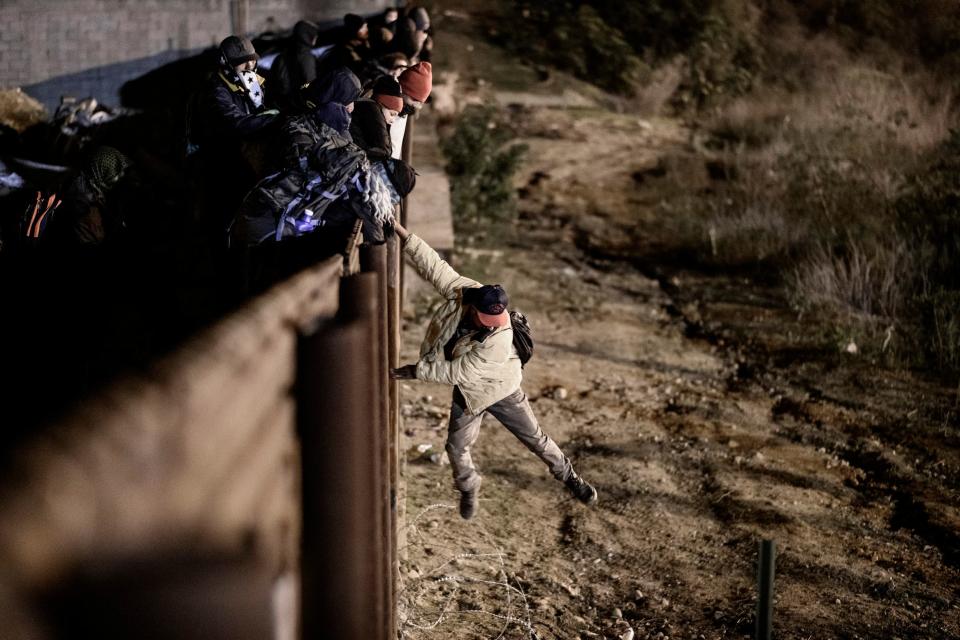Trump administration officials admit mistakes while trying to tie terrorism to southern border
In the days leading up to President Donald Trump's televised address to the nation on Tuesday night to promote his southern border wall, administration officials have justified the proposal by claiming that thousands of terrorists are pouring across that border.
But data and analysis from his own administration have drastically undercut that message, calling into question whether the situation along the U.S.-Mexico border is truly a "national emergency" as Trump has increasingly claimed.
White House press secretary Sarah Sanders said on Friday that Customs and Border Protection officials caught nearly 4,000 known or suspected terrorists "that came across our southern border." She repeated that claim on talk shows throughout the weekend, and Vice President Mike Pence used the same data point during an appearance on "Good Morning America" on Tuesday.
But in the State Department's summary of global terrorism threats published in September, analysts concluded that there was "no credible evidence indicating that international terrorist groups...sent operatives via Mexico into the United States."
On Monday, NBC News reported that the number of known or suspected terrorists actually caught along the southern border by CBP in the first half of 2018 was about 1 percent of the Trump administration's claim. According to CBP data provided to Congress, the agency encountered 41 people on the Terrorist Screening Database from Oct. 1, 2017, to March 31, 2018, along the U.S.-Mexico border, with 35 of them being American citizens or lawful permanent residents and only six of them classified as non-U.S. persons.
Later Monday night, White House adviser Kellyanne Conway acknowledged during an appearance on Fox News that Sanders had been conflating two very different statistics while trying to make her argument. In fiscal year 2017, federal officials stopped 3,755 people on the terrorist watch list from traveling to or entering the United States, but that includes people traveling through airports, seaports and land ports. The vast majority of those attempt to enter by air.
"That was an unfortunate misstatement," Conway said of Sanders. "Everybody makes mistakes, all of us. The fact is, it's corrected here."

In a statement on Monday, Department of Homeland Security Secretary Kirstjen Nielsen said she did not provide an exact number of how many of those on the terrorist watch list were stopped at the southern border, saying it was “sensitive” and could not publicly be released. Yet Homeland Security has not disputed the accuracy of the NBC News report that found only 41 known or suspected terrorist were caught there.
As criticism of its terrorism statistics have increased in recent days, administration officials have started using another metric to warn of potential dangers crossing the border.
In 2018, CBP agents encountered more than 3,000 "special interest aliens" at the southern border. That is a loose definition that does not indicate any kind of specific intelligence on that person, only that they've traveled to or come from 35 countries deemed to be of "special interest" following the Sept. 11 terrorist attacks because of their historic ties to terrorism.
Nielsen cited those special interest aliens on Monday in a series of tweets warning that "the threat is real."
The threat is real. The number of terror-watchlisted encountered at our Southern Border has increased over the last two years. The exact number is sensitive and details about these cases are extremely sensitive.
— Sec. Kirstjen Nielsen (@SecNielsen) January 8, 2019
But in a separate statement that followed those tweets, Nielsen made clear that being designated a "special interest alien" does not mean the person is a national security threat.
"This does not mean that all (special interest aliens) are 'terrorists,' but rather that the travel and behavior of such individuals indicates a possible nexus to nefarious activity (including terrorism) and, at a minimum, provides indicators that necessitate heightened screening and further investigation," she wrote. "The term (special interest alien) does not indicate any specific derogatory information about the individual — and DHS has never indicated that the (special interest alien) designation means more than that."
This article originally appeared on USA TODAY: Trump administration officials admit mistakes while trying to tie terrorism to southern border

